2005 NISSAN X-TRAIL roof rack
[x] Cancel search: roof rackPage 3834 of 4555

EI-8
SQUEAK AND RATTLE TROUBLE DIAGNOSES
TRUNK
Trunk noises are often caused by a loose jack or loose items put into the trunk by the owner.
In addition look for:
1. Trunk lid dumpers out of adjustment
2. Trunk lid striker out of adjustment
3. Trunk lid torsion bars knocking together
4. A loose license plate or bracket
Most of these incidents can be repaired by adjusting, securing or insulating the item(s) or component(s) caus-
ing the noise.
SUNROOF/HEADLINING
Noises in the sunroof/headlining area can often be traced to one of the following:
1. Sunroof lid, rail, linkage or seals making a rattle or light knocking noise
2. Sun-visor shaft shaking in the holder
3. Front or rear windshield touching headlining and squeaking
Again, pressing on the components to stop the noise while duplicating the conditions can isolate most of these
incidents. Repairs usually consist of insulating with felt cloth tape.
SEATS
When isolating seat noise it's important to note the position the seat is in and the load placed on the seat when
the noise is present. These conditions should be duplicated when verifying and isolating the cause of the
noise.
Cause of seat noise include:
1. Headrest rods and holder
2. A squeak between the seat pad cushion and frame
3. Rear seat back lock and bracket
These noises can be isolated by moving or pressing on the suspected components while duplicating the con-
ditions under which the noise occurs. Most of these incidents can be repaired by repositioning the component
or applying urethane tape to the contact area.
UNDERHOOD
Some interior noise may be caused by components under the hood or on the engine wall. The noise is then
transmitted into the passenger compartment.
Causes of transmitted under-hood noise include:
1. Any component mounted to the engine wall
2. Components that pass through the engine wall
3. Engine wall mounts and connectors
4. Loose radiator mounting pins
5. Hood bumpers out of adjustment
6. Hood striker out of adjustment
These noise can be difficult to isolate since they cannot be reached from the interior of the vehicle. The best
method is to secure, move or insulate one component at a time and test drive the vehicle. Also, engine RPM
or load can be changed to isolate the noise. Repairs can usually be made by moving, adjusting securing, or
insulating the component causing the noise.
Page 3853 of 4555
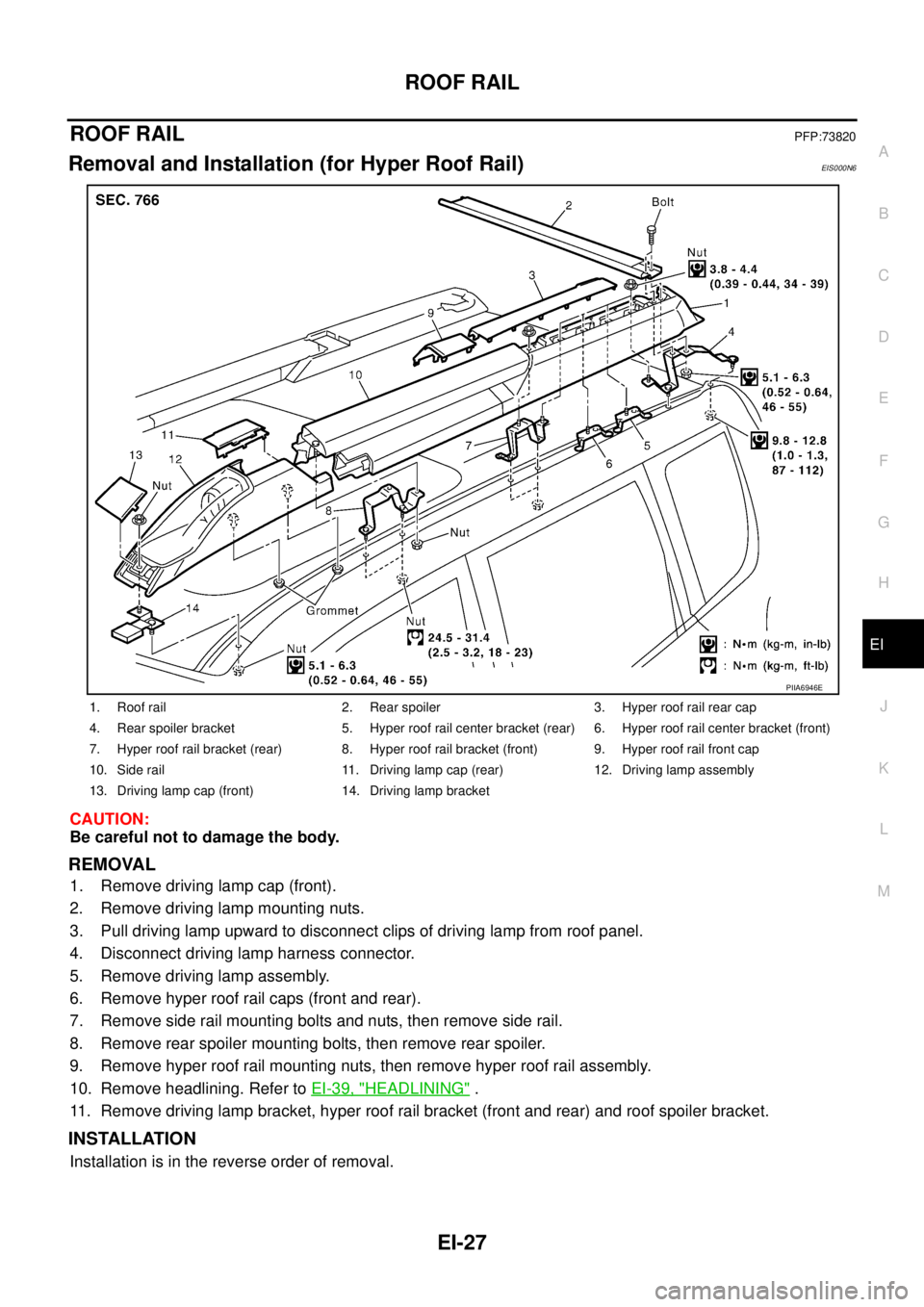
ROOF RAIL
EI-27
C
D
E
F
G
H
J
K
L
MA
B
EI
ROOF RAILPFP:73820
Removal and Installation (for Hyper Roof Rail)EIS000N6
CAUTION:
Be careful not to damage the body.
REMOVAL
1. Remove driving lamp cap (front).
2. Remove driving lamp mounting nuts.
3. Pull driving lamp upward to disconnect clips of driving lamp from roof panel.
4. Disconnect driving lamp harness connector.
5. Remove driving lamp assembly.
6. Remove hyper roof rail caps (front and rear).
7. Remove side rail mounting bolts and nuts, then remove side rail.
8. Remove rear spoiler mounting bolts, then remove rear spoiler.
9. Remove hyper roof rail mounting nuts, then remove hyper roof rail assembly.
10. Remove headlining. Refer to EI-39, "
HEADLINING" .
11. Remove driving lamp bracket, hyper roof rail bracket (front and rear) and roof spoiler bracket.
INSTALLATION
Installation is in the reverse order of removal.
1. Roof rail 2. Rear spoiler 3. Hyper roof rail rear cap
4. Rear spoiler bracket 5. Hyper roof rail center bracket (rear) 6. Hyper roof rail center bracket (front)
7. Hyper roof rail bracket (rear) 8. Hyper roof rail bracket (front) 9. Hyper roof rail front cap
10. Side rail 11. Driving lamp cap (rear) 12. Driving lamp assembly
13. Driving lamp cap (front) 14. Driving lamp bracket
PIIA6946E
Page 3854 of 4555
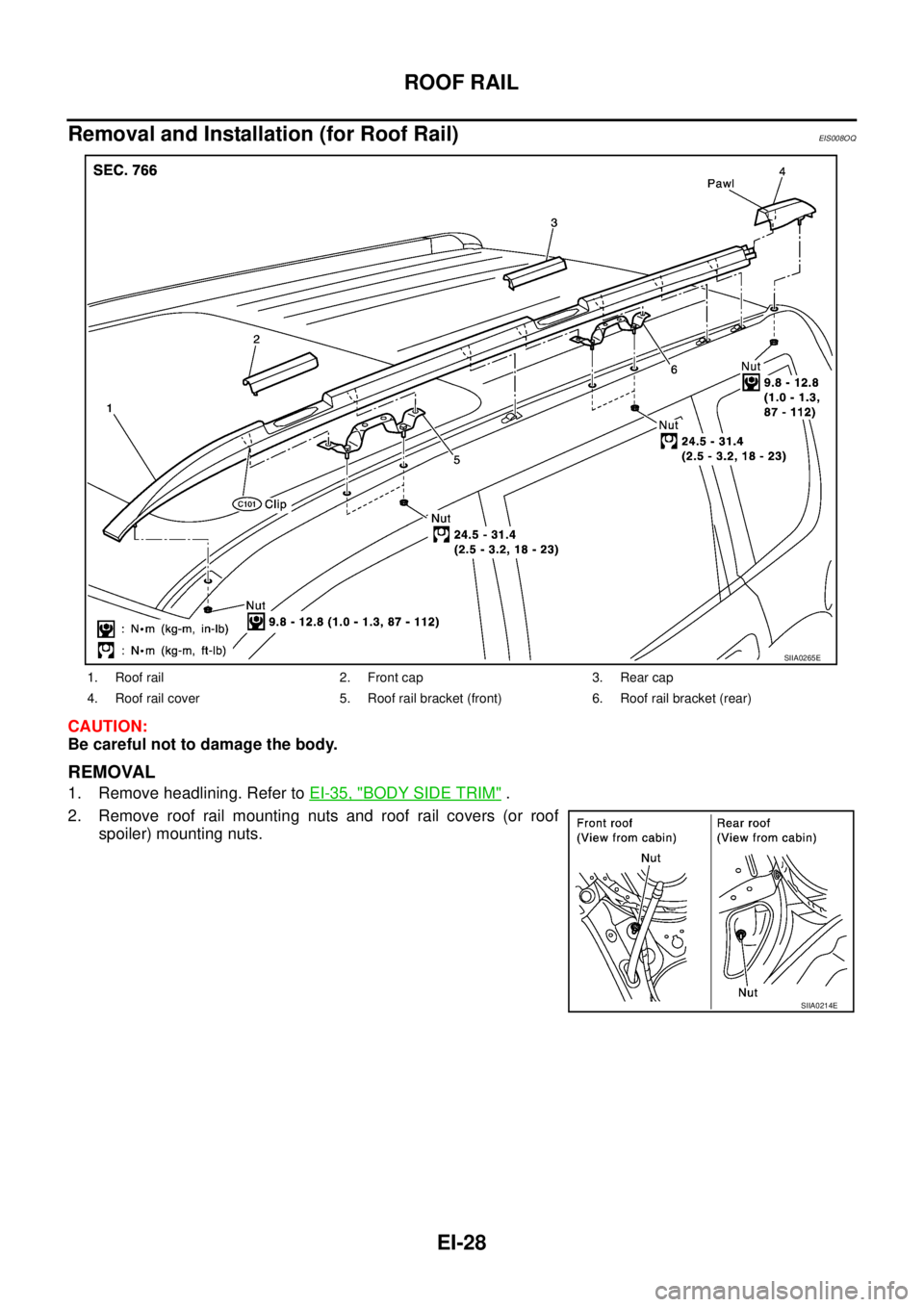
EI-28
ROOF RAIL
Removal and Installation (for Roof Rail)EIS008OQ
CAUTION:
Be careful not to damage the body.
REMOVAL
1. Remove headlining. Refer to EI-35, "BODY SIDE TRIM" .
2. Remove roof rail mounting nuts and roof rail covers (or roof
spoiler) mounting nuts.
1. Roof rail 2. Front cap 3. Rear cap
4. Roof rail cover 5. Roof rail bracket (front) 6. Roof rail bracket (rear)
SIIA0265E
SIIA0214E
Page 3855 of 4555
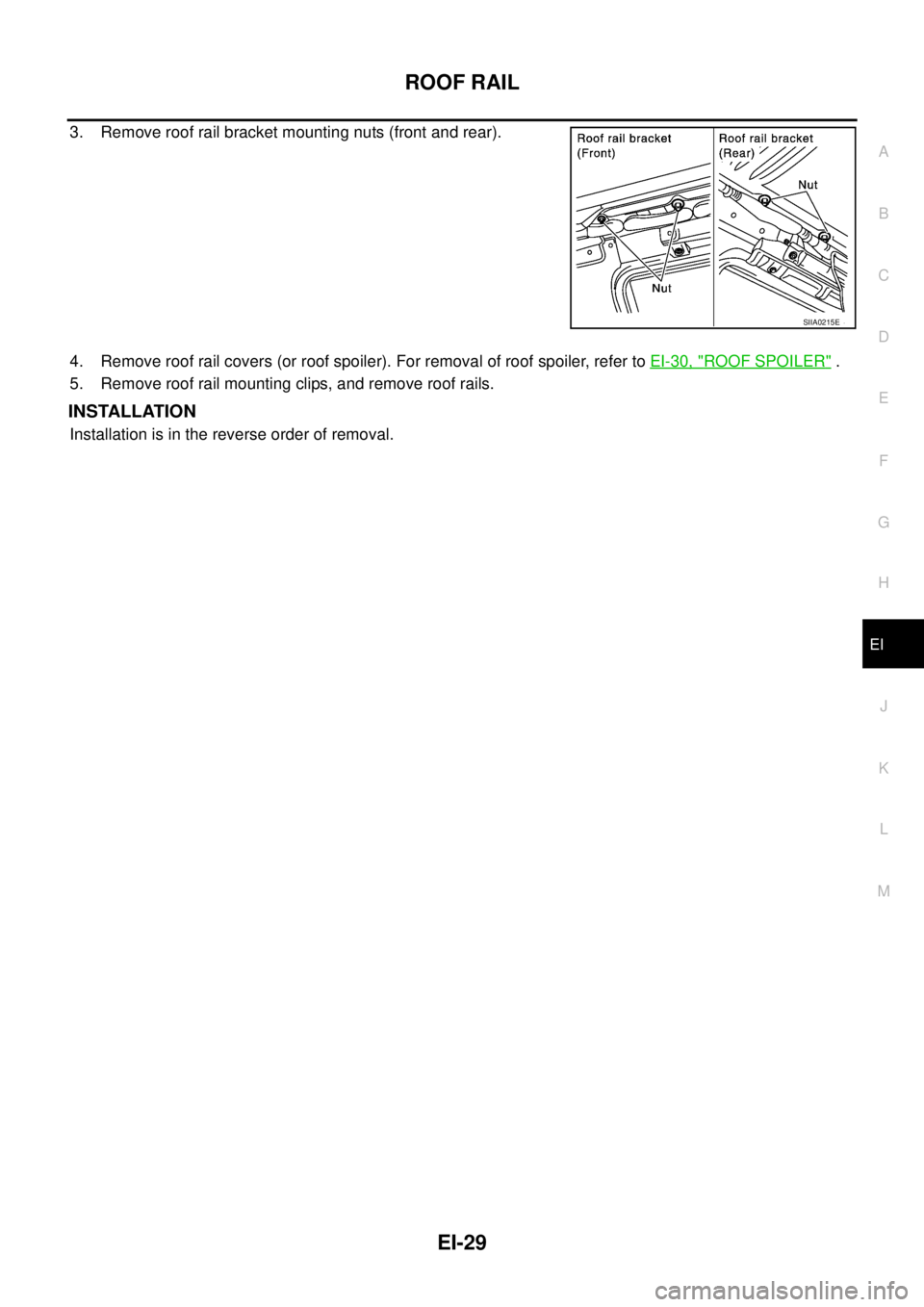
ROOF RAIL
EI-29
C
D
E
F
G
H
J
K
L
MA
B
EI
3. Remove roof rail bracket mounting nuts (front and rear).
4. Remove roof rail covers (or roof spoiler). For removal of roof spoiler, refer to EI-30, "
ROOF SPOILER" .
5. Remove roof rail mounting clips, and remove roof rails.
INSTALLATION
Installation is in the reverse order of removal.
SIIA0215E
Page 3873 of 4555
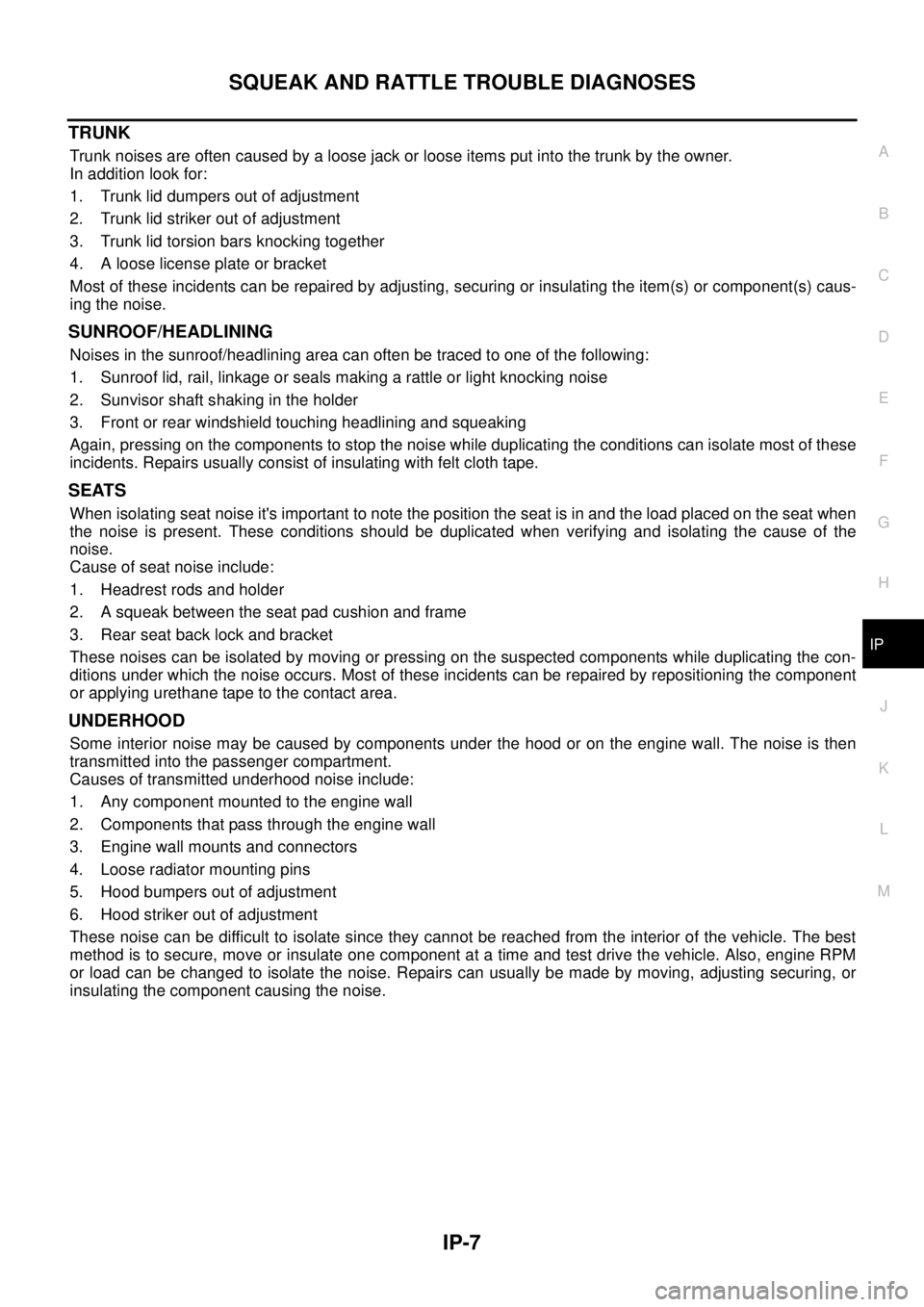
SQUEAK AND RATTLE TROUBLE DIAGNOSES
IP-7
C
D
E
F
G
H
J
K
L
MA
B
IP
TRUNK
Trunk noises are often caused by a loose jack or loose items put into the trunk by the owner.
In addition look for:
1. Trunk lid dumpers out of adjustment
2. Trunk lid striker out of adjustment
3. Trunk lid torsion bars knocking together
4. A loose license plate or bracket
Most of these incidents can be repaired by adjusting, securing or insulating the item(s) or component(s) caus-
ing the noise.
SUNROOF/HEADLINING
Noises in the sunroof/headlining area can often be traced to one of the following:
1. Sunroof lid, rail, linkage or seals making a rattle or light knocking noise
2. Sunvisor shaft shaking in the holder
3. Front or rear windshield touching headlining and squeaking
Again, pressing on the components to stop the noise while duplicating the conditions can isolate most of these
incidents. Repairs usually consist of insulating with felt cloth tape.
SEATS
When isolating seat noise it's important to note the position the seat is in and the load placed on the seat when
the noise is present. These conditions should be duplicated when verifying and isolating the cause of the
noise.
Cause of seat noise include:
1. Headrest rods and holder
2. A squeak between the seat pad cushion and frame
3. Rear seat back lock and bracket
These noises can be isolated by moving or pressing on the suspected components while duplicating the con-
ditions under which the noise occurs. Most of these incidents can be repaired by repositioning the component
or applying urethane tape to the contact area.
UNDERHOOD
Some interior noise may be caused by components under the hood or on the engine wall. The noise is then
transmitted into the passenger compartment.
Causes of transmitted underhood noise include:
1. Any component mounted to the engine wall
2. Components that pass through the engine wall
3. Engine wall mounts and connectors
4. Loose radiator mounting pins
5. Hood bumpers out of adjustment
6. Hood striker out of adjustment
These noise can be difficult to isolate since they cannot be reached from the interior of the vehicle. The best
method is to secure, move or insulate one component at a time and test drive the vehicle. Also, engine RPM
or load can be changed to isolate the noise. Repairs can usually be made by moving, adjusting securing, or
insulating the component causing the noise.
Page 3889 of 4555
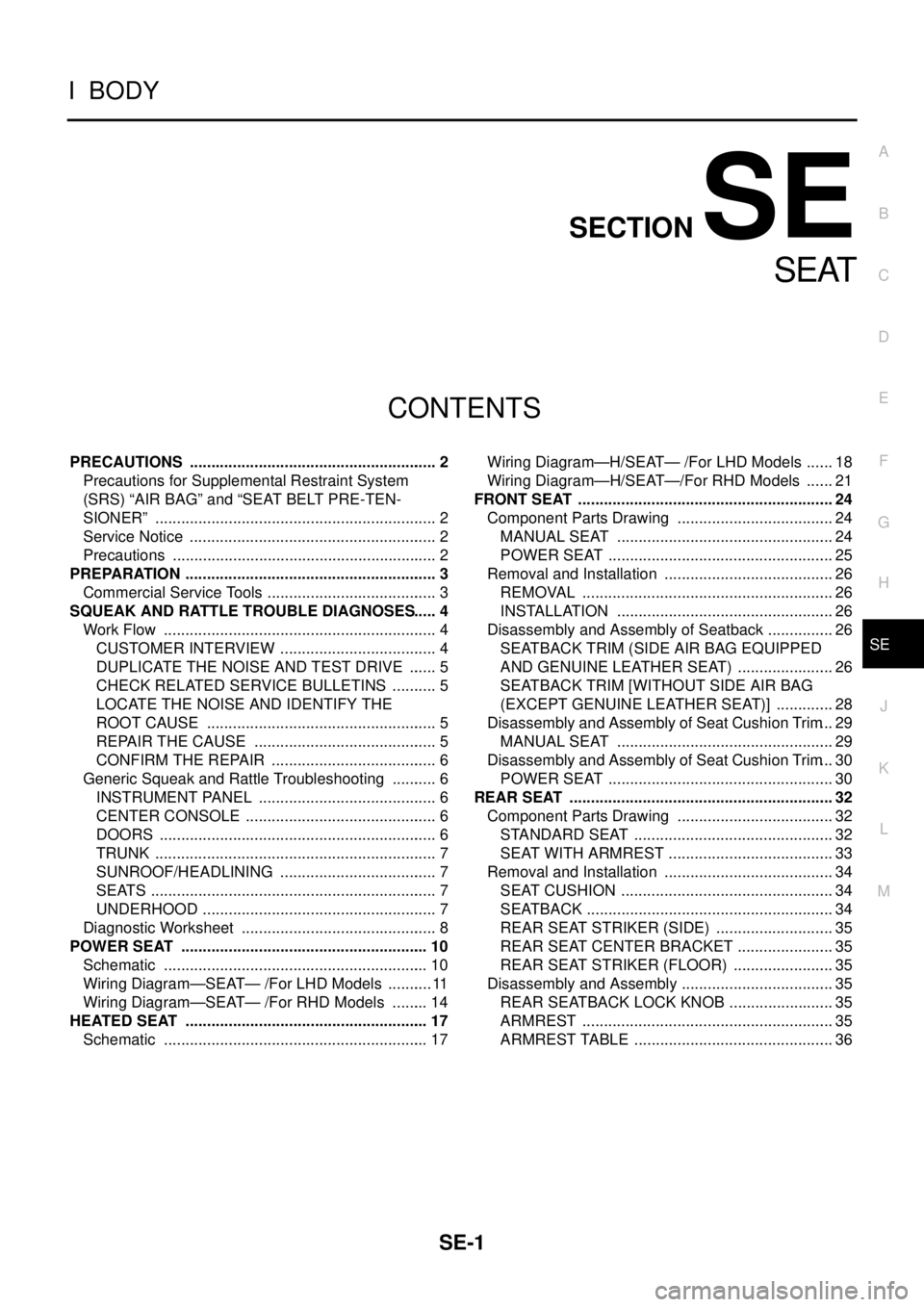
SE-1
SEAT
I BODY
CONTENTS
C
D
E
F
G
H
J
K
L
M
SECTION SE
A
B
SE
SEAT
PRECAUTIONS .......................................................... 2
Precautions for Supplemental Restraint System
(SRS) “AIR BAG” and “SEAT BELT PRE-TEN-
SIONER” .................................................................. 2
Service Notice .......................................................... 2
Precautions .............................................................. 2
PREPARATION ........................................................... 3
Commercial Service Tools ........................................ 3
SQUEAK AND RATTLE TROUBLE DIAGNOSES ..... 4
Work Flow ................................................................ 4
CUSTOMER INTERVIEW ..................................... 4
DUPLICATE THE NOISE AND TEST DRIVE ....... 5
CHECK RELATED SERVICE BULLETINS ........... 5
LOCATE THE NOISE AND IDENTIFY THE
ROOT CAUSE ...................................................... 5
REPAIR THE CAUSE ........................................... 5
CONFIRM THE REPAIR ....................................... 6
Generic Squeak and Rattle Troubleshooting ........... 6
INSTRUMENT PANEL .......................................... 6
CENTER CONSOLE ............................................. 6
DOORS ................................................................. 6
TRUNK .................................................................. 7
SUNROOF/HEADLINING ..................................... 7
SEATS ................................................................... 7
UNDERHOOD ....................................................... 7
Diagnostic Worksheet .............................................. 8
POWER SEAT .......................................................... 10
Schematic .............................................................. 10
Wiring Diagram—SEAT— /For LHD Models ........... 11
Wiring Diagram—SEAT— /For RHD Models ......... 14
HEATED SEAT ......................................................... 17
Schematic .............................................................. 17Wiring Diagram—H/SEAT— /For LHD Models ....... 18
Wiring Diagram—H/SEAT—/For RHD Models ....... 21
FRONT SEAT ............................................................ 24
Component Parts Drawing ..................................... 24
MANUAL SEAT ................................................... 24
POWER SEAT ..................................................... 25
Removal and Installation ........................................ 26
REMOVAL ........................................................... 26
INSTALLATION ................................................... 26
Disassembly and Assembly of Seatback ................ 26
SEATBACK TRIM (SIDE AIR BAG EQUIPPED
AND GENUINE LEATHER SEAT) ....................... 26
SEATBACK TRIM [WITHOUT SIDE AIR BAG
(EXCEPT GENUINE LEATHER SEAT)] .............. 28
Disassembly and Assembly of Seat Cushion Trim ... 29
MANUAL SEAT ................................................... 29
Disassembly and Assembly of Seat Cushion Trim ... 30
POWER SEAT ..................................................... 30
REAR SEAT .............................................................. 32
Component Parts Drawing ..................................... 32
STANDARD SEAT ............................................... 32
SEAT WITH ARMREST ....................................... 33
Removal and Installation ........................................ 34
SEAT CUSHION .................................................. 34
SEATBACK .......................................................... 34
REAR SEAT STRIKER (SIDE) ............................ 35
REAR SEAT CENTER BRACKET ....................... 35
REAR SEAT STRIKER (FLOOR) ........................ 35
Disassembly and Assembly .................................... 35
REAR SEATBACK LOCK KNOB ......................... 35
ARMREST ........................................................... 35
ARMREST TABLE ............................................... 36
Page 3895 of 4555
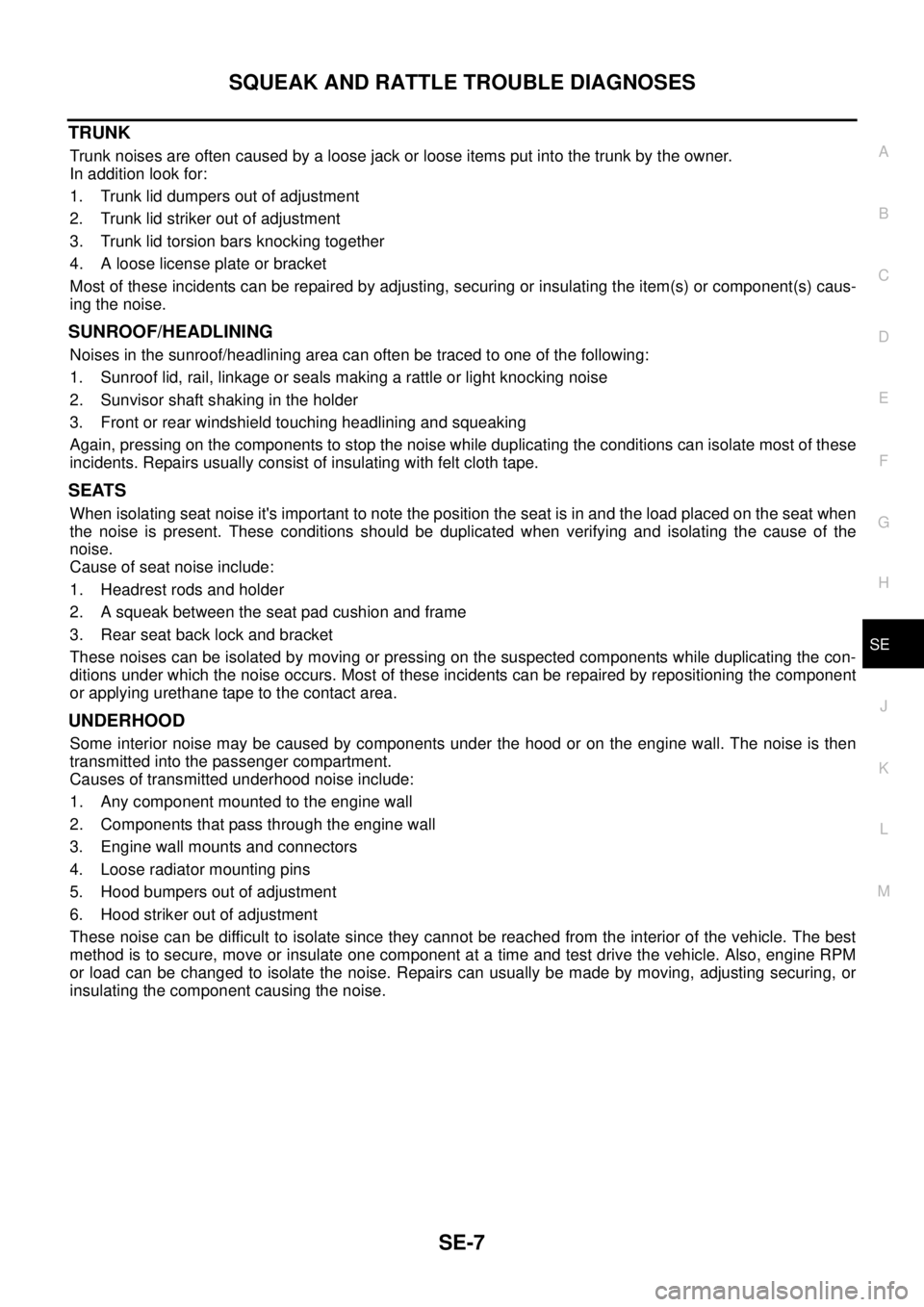
SQUEAK AND RATTLE TROUBLE DIAGNOSES
SE-7
C
D
E
F
G
H
J
K
L
MA
B
SE
TRUNK
Trunk noises are often caused by a loose jack or loose items put into the trunk by the owner.
In addition look for:
1. Trunk lid dumpers out of adjustment
2. Trunk lid striker out of adjustment
3. Trunk lid torsion bars knocking together
4. A loose license plate or bracket
Most of these incidents can be repaired by adjusting, securing or insulating the item(s) or component(s) caus-
ing the noise.
SUNROOF/HEADLINING
Noises in the sunroof/headlining area can often be traced to one of the following:
1. Sunroof lid, rail, linkage or seals making a rattle or light knocking noise
2. Sunvisor shaft shaking in the holder
3. Front or rear windshield touching headlining and squeaking
Again, pressing on the components to stop the noise while duplicating the conditions can isolate most of these
incidents. Repairs usually consist of insulating with felt cloth tape.
SEATS
When isolating seat noise it's important to note the position the seat is in and the load placed on the seat when
the noise is present. These conditions should be duplicated when verifying and isolating the cause of the
noise.
Cause of seat noise include:
1. Headrest rods and holder
2. A squeak between the seat pad cushion and frame
3. Rear seat back lock and bracket
These noises can be isolated by moving or pressing on the suspected components while duplicating the con-
ditions under which the noise occurs. Most of these incidents can be repaired by repositioning the component
or applying urethane tape to the contact area.
UNDERHOOD
Some interior noise may be caused by components under the hood or on the engine wall. The noise is then
transmitted into the passenger compartment.
Causes of transmitted underhood noise include:
1. Any component mounted to the engine wall
2. Components that pass through the engine wall
3. Engine wall mounts and connectors
4. Loose radiator mounting pins
5. Hood bumpers out of adjustment
6. Hood striker out of adjustment
These noise can be difficult to isolate since they cannot be reached from the interior of the vehicle. The best
method is to secure, move or insulate one component at a time and test drive the vehicle. Also, engine RPM
or load can be changed to isolate the noise. Repairs can usually be made by moving, adjusting securing, or
insulating the component causing the noise.
Page 4019 of 4555
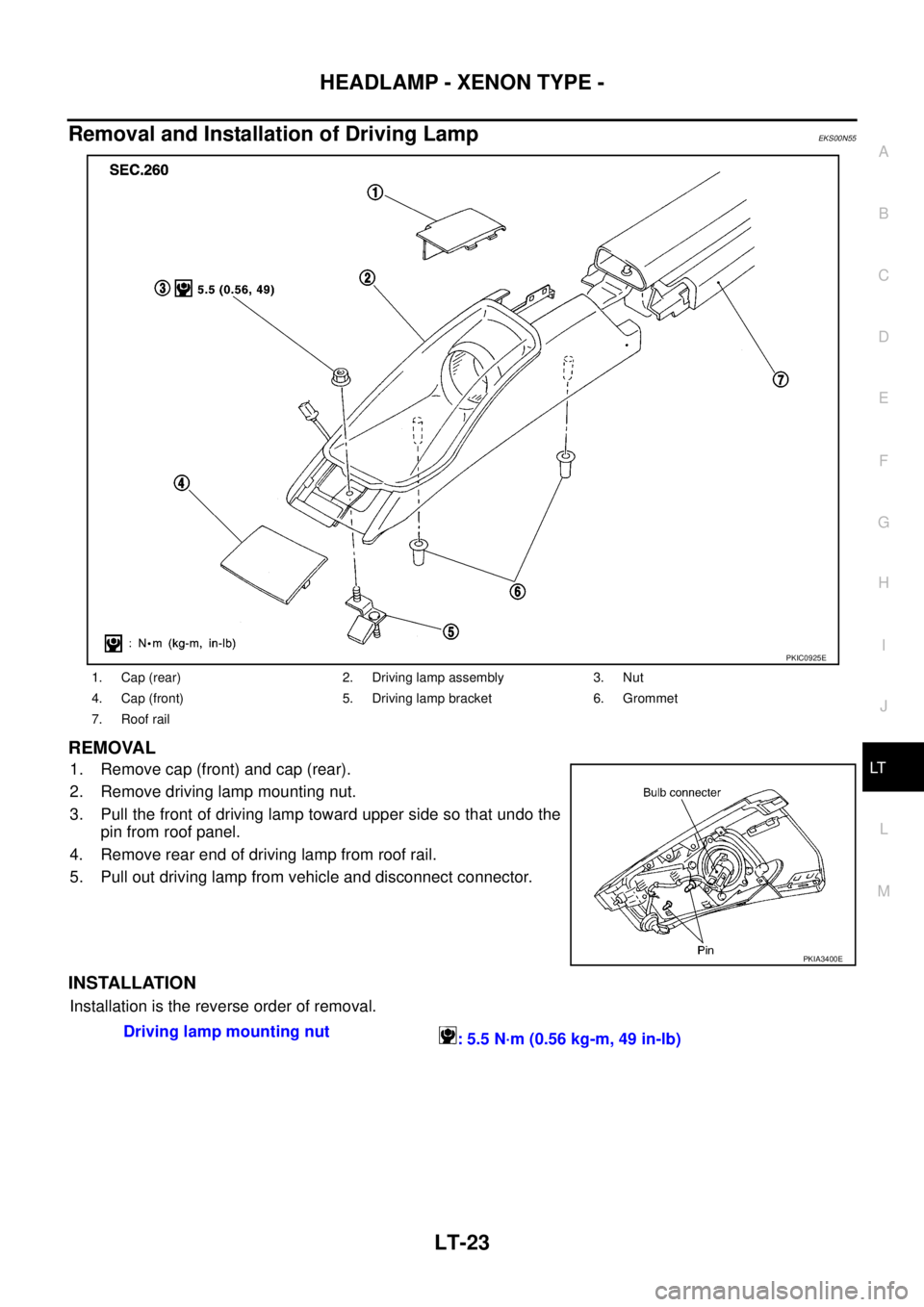
HEADLAMP - XENON TYPE -
LT-23
C
D
E
F
G
H
I
J
L
MA
B
LT
Removal and Installation of Driving LampEKS00N55
REMOVAL
1. Remove cap (front) and cap (rear).
2. Remove driving lamp mounting nut.
3. Pull the front of driving lamp toward upper side so that undo the
pin from roof panel.
4. Remove rear end of driving lamp from roof rail.
5. Pull out driving lamp from vehicle and disconnect connector.
INSTALLATION
Installation is the reverse order of removal.
1. Cap (rear) 2. Driving lamp assembly 3. Nut
4. Cap (front) 5. Driving lamp bracket 6. Grommet
7. Roof rail
PKIC0925E
PKIA3400E
Driving lamp mounting nut
: 5.5 N·m (0.56 kg-m, 49 in-lb)